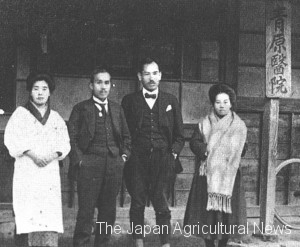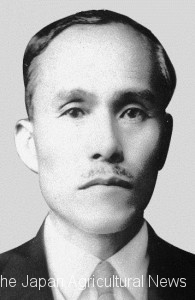Contributed to the welfare of farmers
In 1900 (Meiji 33), when sangyokumiai (cooperatives) law was established, a young man was walking 80km of the way beyond the Chugoku Mountains from Iwami region of western edge of Shimane Prefecture. He was heading to the Hatsukaichishi station of Sanyo line (Hiroshima prefecture), for getting admission to the Kyoto municipal agricultural school (now Kyoto Prefectural University). Name of the man, who was getting on train for Kyoto which he saw for the first time, was Masayo Oba ( = 1882 ~ 1939 ). He was the man who worked on the medical business of Sangyokumiai (cooperatives) later.
After graduation, Oba became the assistant engineer of the Aichi Prefectural Agricultural Experiment Station. Then, in 1907 (Meiji 40), he became adopted child of Oba family of hometown in Shimane Prefecture. There was Aoharason sangyokumiai (cooperatives of Aohara village), which was already established servicing only credit business. Oba planned that sangyokumiai (cooperatives) should run all 4 business such as credit, marketing, purchasing, and utilization, so that it could cover everything about village life.
In December 1918 (Taisho 7), extraordinary general meeting of sangyokumiai was opened. Oba was elected president. At the same time, articles of incorporation were changed so as to serve 4 kinds of businesses.
Later, Oba described in his book “actuality of nosonsangyokumiai (rural cooperatives) management” as follows;
“We aim for reconstruction of rural area by organization of sangyokumiai (cooperatives). We go toward the directions, such as 1) construction of personality civilization viewed from the thought direction, 2) economic independence viewed from the economic direction, 3) rationalization of agricultural management organization viewed from industry direction. ”
Then Aoharason sangyokumiai (cooperatives of Aohara village) tackled new business such as brewing of soy sauce and sake, producing paper by mulberry and mitsumata (oriental paper bush), rice polishing, flour milling, and artificial insemination of cattle. And at last, it achieved at medical business.
Prefectural permission, aiming for protection of production force
When Oba was appointed to president of sangyokumiai, Aohara village had a population of 2300 people (390 houses), number of cooperatives members was 256. Previously in the village there were 2 doctors, but both was dead. Covered by recession after the First World War, medical cost was high despite of cheapness of agricultural products. If sick, farmers had been exposed to the danger of life.
The cooperatives opened an extraordinary general meeting in September 1919, so as to resolve the start of the medical business for the farmers of welfare. Oba applicated to Shimane Prefecture for the approval of amendments to the Articles of Incorporation to add “medical care business” in production business. Officials of Shimane Prefecture made an inquiry to the Ministry of Agriculture and Commerce about the application, and the Ministry answered, “The spirit is a truly fine, but across the country there was no example like this and the application as production business is doubtful. In this case, it’s better to applicate as a supplementary business.”
However, the Commerce and Industry Division of Shimane prefecture built a logical that, “Productivity of residents are declined significantly because of illness. Therefore, medical equipment can be regarded as a fine production equipment because recovering their health by it can maintain its labor efficiency, so as to lead the improvement and protection of the productivity. ” Prefectural official re-inquired the Ministry of Agriculture and Commerce, and medical business was approved as part of the production business (Ikuo Aoki “Aspects of initial medical utilization cooperatives” = Hannan University Papers No. 24, the first Volume No.2).
◇

Masayo Oba and opened Aohara clinic. From the left, the second person is Oba, president, (History of Nogyokyodokumiai (agricultural cooperatives) Nichihara town)
In November 1919, next to the post office, the Signboard of the “Aoharaiin (Aohara clinic)” was raised. It was the first medical institutions that was opened by sangyokumiai (cooperatives) in Japan. About 85 square meters house, which had been borrowed by sangyokumiai, was remodeled into doctor’s office, pharmacy, and patient waiting room. Medical equipment and drugs were purchased cheaply from the doctor living in Ono village of Mino-gun.
The clinic commissioned two doctors living Nichihara village, nearby village. The doctors worked initially in the afternoon every other day. In the following year, 4 doctors worked every day in the afternoon, except for 5th and 10th. The medical examination fee was free, and the visiting medical examination fee was 1 yen per 4km. Rates of surgery and supply drugs was 80% of provisions of the county medical association. In 1924 (Taisho 13), the clinic hired two midwives, and established a maternity hospital together.
According to Aoki’s “Aspects of initial medical utilization cooperatives”, after all households of the village became members of cooperatives, total number of patients of the clinic at the late Taisho period was 2000 per year, and the number of patients of the maternity hospital was 40, 50 per year. Medical business was not profit purposes. But, the clinic had recorded surplus at Taisho period.
However, upon entering the Showa period, also overlapped the Showa Depression, number of patients unable to pay the charge for medicine by due date increased, so that the clinic’s management became difficult. Oba continued to claim, “For health improvement of the masses, it’s necessary to create General Hospital established by cooperatives and covering wide area.” When the General Hospital was established, in Nichiharacho (Nichihara town), in the form of merger with the hospital, the cooperatives abolished the medical business.
“History of Nogyokyodokumiai (agricultural cooperatives) of Shimane Prefecture ” rated, “Although it can’t be said that medical business was successful, but its significance is valuable as the first attempt in the history of cooperatives medical business.”


